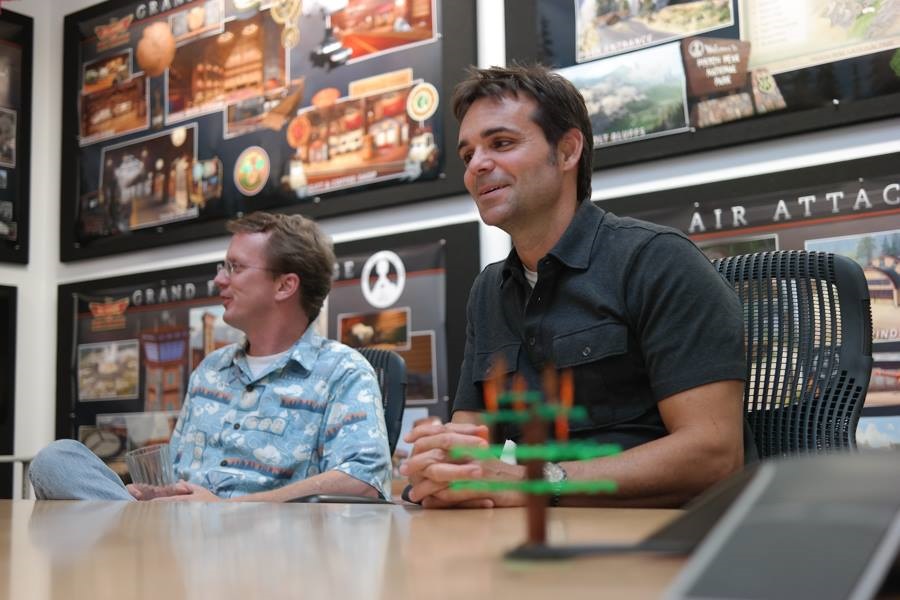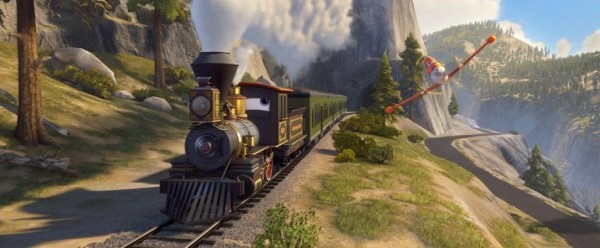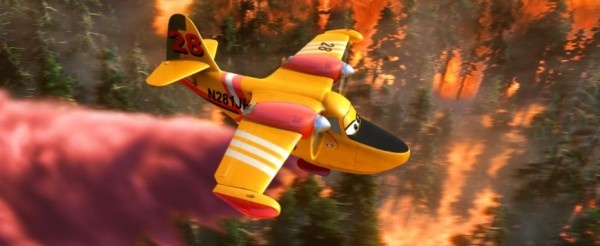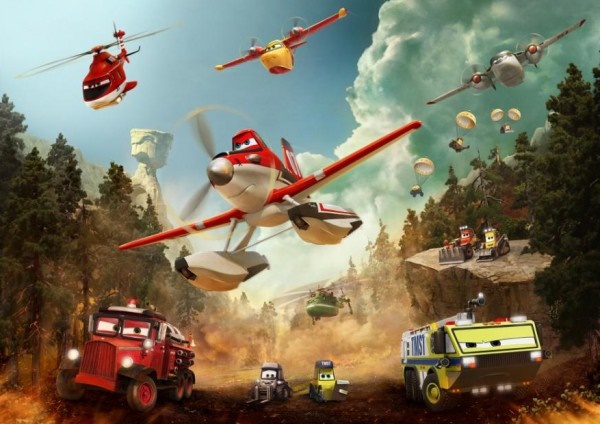I recently had the opportunity to visit DisneyToon Studios and sit down with Bobs Gannaway, Director, and Ferrell Barron, Producer, of Disney’s Planes Fire and Rescue. Wow, there is nothing on this earth like Disney. I love Disney with all my heart. I don’t care how old you are, you are never to old for Disney! I’ve added the entire interview with them so you can see just how cool they really are.
Q: Is there a third one [Planes movie]?
Ferrell Barron (FB) on the right: First one. First question. Hard reporter.
BG: You know, what’s interesting about Disney Toon Studios, John Lassiter is such a wonderful, creative leader. He’s a filmmaker, which is great, to have a filmmaker, a fantastic filmmaker, sort of heading the studios that he oversees.
Disney Animation Studios. And Pixar. Disney Toons. And, so these things take so long to make. It’s five years of your life to make. Even though this came out a year later, still, we didn’t make it in a year.
FB: Long time.
BG: And so, they can’t feel like assignments, because they are something that you’re going to basically pour yourself into. So he [John Lassiter] really waits for his filmmakers to be inspired by something, and to go out there, and research it, and meet the people, ride in the vehicles, and come back and tell him and everyone on the team what you’d discovered that was cool.
We hope to make more stories in this world, but we will wait until we find the right thing. That everybody kind of sort of wants to commit to for five years. Because it’s a huge commitment, and it has to be a passion, not an assignment. Ultimately I hope to make more. Like I said, I’m still here.
We finished the movie, I’m still coming in every day, and no one’s said stop. So I think we probably will do some more.
 Image courtesy of Laura Franklin
Image courtesy of Laura Franklin
Q: Do you see Planes: Fire and Rescue as the new Smokey the Bear?
FB: We say Scorchy is the new Smokey the Bear.
BG: We did work with the campaign with the park service.
FB: We did do some PSA’s with the park service about that. I think for us it was mainly wanting to pay tribute to the firefighters around the world. We’re focusing on wildfire air attack, but it’s really for all firefighters. I’m sure you saw Cal Fire, who we worked with.
I mean, it was really important for us, after we’d met them. They became more than just consultants. They really became our friends. I still stay in touch with Travis Alexander, who you probably saw in the pictures. Big Travis. Julie Hutchinson. They really became our friends. And so it was important for us to do right by them, because of all that research, bringing that truth and accuracy to our film making, so that all firefighters really are honored.
You know, that we did that. In the movie, we have the wall of fame. And a couple of the aircraft on there were actual Cal Fire airplanes that went down. We put them with the numbers, and it’s the actual aircraft, and we put that in there. And they were really taken aback, and it’s such an honor that we honored those brave men and woman that actually lost their lives, but that’s in the movie. But, you know, the public is not gonna know that, but they saw it, and it’s something that really.
BG: Someone picked up on that. This aircraft here is one that actually crashed in Cal Fire and we don’t say that in the movie, but that’s the number of the plane that crashed, and someone picked up on it and wrote an article about it, as an honor to that firefighter. And when we showed the movie to Cal Fire, they were like, “that’s a lovely thing to do.” And it’s just the tiny little details we worked with the forest service. If you listen, the fire in the movie is caused by lightning.
Because I didn’t want it to be a whodunit situation where we’re trying to track down an arsonist. The majority of the fires are caused by lightning. There are over 50,000 wild fires a year in the US, it’s crazy, and these firefighters are out there, putting them out all of the time. But some of them are caused by humans. If you listen carefully, on the dialogue, you hear that the caused by an unattended campfire.
And that’s something we put in for the forest service, because we wanted to push their message a little bit.
FB: That’s part of their campaign, be careful, put your fire out.
BG: It’s little things like that that we do because the people we work with, the park service, Cal Fire, they become our friends, and we want to do right by them.
Q: I’m curious about the process. I’ve heard you guys talk about keeping the scenes versus letting them stay. Do you ever worry about letting something go?
BG: That’s what’s so great and hard about the animation process. It’s very different than a live-action where you’ve written a script and you go out and you shoot the script. You have lots of coverage, and then it’s made kind of in editorial, and then maybe you do re-shoot in live action. In a live action movie, it gets turned around fairly quickly. By that I mean, a year and a half. These [animation films]take five plus years to make. What we do is, we write a script, and then we do boards and do temp dialogue and do temp music, and then put it together in the editorial, and then we watch it with all of our other directors, and then even the whole studio and we all get notes, and then we tear down and rebuild it, and tear down and rebuild it, so it’s a constant. So the movie you’re seeing is the eighth or ninth version of the film. During that two years, or that two and a half years, or three years, or however long you’re doing that, you start to sort of figure out, “We don’t need that,” or “This needs to move along quickly,” or “There’s a pace issue.” Things like that. There will be scenes that are in for a long time.
There was a scene in the movie that was in for the longest time, and it was the scene where Blade has crashed. And Dusty’s flying around, and he calls for help, and then we had this very lovely scene where Windlifter was carrying Blade back to base. And Dusty’s flying alongside, and we’re playing temp music in there, “A River Once Stood” or something. And everybody was like, “Oh. This is so emotional, and wonderful, and oh, I’m just feeling so much,” and then finally, John Lassiter said, “Yeah. That’s great, and everything, but there’s something bugging me about it.” And we sat there, looked at it for a while. And he goes, “Oh, I know what it is. He’s still alive. Ambulances don’t go slow. They go fast. Funerals go slow. He’s not dead.” So we’re like, “Oh my gosh, we gotta get him back, and on the base, and then Maru is doing triage right there in the moment.” So, that scene was in there for two years before we realized that it was completely and utterly wrong, and the characters were not reacting in this scene.
We had fallen so in love with the emotion. We had blinders on to this emotion, we didn’t look at it relative to what would happen in real life. But, what happened was, that little moment where they’re bringing Blade back, we sort of gave [it]to after Dusty crashes where we’re not sure whether Dusty is alive or not. So we still got to have that moment. We just gave it to a different character. And then what we ended up getting out of it was this lovely scene where Maru, Curtis Armstrong, who was fantastic. He’s like, the waterboy, right?
He doesn’t get to fly. He admires these guys. And, so, that’s his moment to shine. When they’re on the ground, he’s gotta put Blade back together. Stuff like that happens, and it takes a long time. That’s why you rely upon the other directors and the people around here to sort of look at you and give you notes, and you look for consensus in those notes. Because when you’re making the movie you’re so into the film, that you might need someone else to go, “Uh, just a question. That doesn’t work at all.”
Yes, it does! It does work! “Okay, don’t get defensive.” But, you listen, and eventually you’re like, “Oh, yeah, you’re right, they would be going fast.” We had some scenes that were taken at the very beginning when Dusty finds out he can’t race anymore, and then they go to Honkers and they hang out, and it’s sort of like the “cry in a beer” moment. Then he kind of went back to his hangar and he looked at all of his trophies, and then he kind of felt sorry for himself.
And then the next morning he sort of snuck out early and went flying. And John said, “No, no, no if he’s really in denial, he’d go flying right then.” So we cut all of that out, so while they’re at Honkers all talking about it, he’s gone, and they go right to him flying. And, oh, would he really just sit around and like, feel sorry for himself and wait till the next day to be in denial? Or he would just go like, no, no, no, I’m a racer. I can still do this, I’ll prove them wrong. I’ll just go fly now. And it ended up being cooler, because now, it’s at night, and now the fire is caused at night, and visually that’s more exciting.
You just go through that over and over again. That’s part of what we call the process.
Q: Had a question about voice actors. How do you select those? Do you have specific people you’re like, “Oh, this person would be perfect for this character,” or do you audition and decide that way?
BG: We cast characters that we feel embody the spirit of the character. We won’t say “oh, here’s an actor, and we want to work with them, let’s create a character for them.” We don’t do that. We’ve created the character, and then we go out and find an actor or actress who we feel like embodies the spirit of that character already. There’s a couple of times when you do have someone in mind already, when maybe you already know you have a character.
Harvey and Winnie [characters in the film]are the perfect example, basically. You have two Winnebagos who are on their 50th wedding anniversary, coming back to Piston Peak to celebrate that. And you want to have instant chemistry between them, and then, from a film making standpoint, it’s a plant, because they are gonna be used later. From a casting standpoint, we got Jerry Stiller and Ann Meara who are a comedy couple who’ve been married for 50 years. It had come preloaded with the chemistry that you’d want to create, so they already embodied the spirit of those characters, and so it was a natural for them to fit into it.
Dale Dye is a veteran, so he’s playing the major ex-military aircraft. Wes Studi is obviously American Indian, and so he’s playing our American Indian helicopter. We got Ed Harris as a tough guy. We wanted to have Dusty’s biggest fan. Someone who’s just on the verge of being a little crazy, hopeful is a better word, and so Julie [Bowen] was fantastic for that.
And, Curtis [Armstrong], I’d worked with many times, and I know how great of an actor he is. And I need somebody who could yell at you, but you don’t take them that seriously. The more he [Curtis Armstrong] shouts, the funnier he gets. So you kind of go in and you figure, who already the spirit of the character?
FB: And you should know voiceover work is really hard work. These actors are confined in a small isolation booth, alone? Because 98 percent of the time, they’re recording alone. They don’t have another actor with them. They’re just there with headsets out, separated out, having to stay on the mics, can’t have them doing a lot of movement.
BG: Not in costume, obviously. [LAUGHTER]
FB: Not in costume. You know. They come in and the director, the voice director, which is usually, Bobs, [is]outside with a sheet of glass between them, reading the lines with them, and they have to perform.
They have to be on cue. And most of these are live action. Ed Harris, he’s used to being in front of a camera with another actor, and working a scene, like in theatre, and having another great actor with him. That’s not the case in animation. It was their first time to do animation, and it was a big adjust for them, as an actor, to be on and embody that character. And bring that emotion just to the forefront every time, and they all did a great job. We always depend on having high caliber actors like Ed, like Julie, who we know are gonna bring more to the character than what the script may provide.
Like we always say, Bobs is really good about having the script being a starting point. Start there. But, if you’re the character, and if you feel like you’re gonna say something else, say what you feel like you’re gonna say. And, most of the time, they may have just ad-libbed. And Bobs liked better. And that’s what we keep, and we cut in, and it’s great. But it’s a lot of hard work, and they all did and that’s a big part of elevating the movie to. The actors you hire. So it’s a long process of figuring out who we think is right, because it’s also about the voice quality, and you want that to be right.
Q: Can you think of a remarkable ad lib you can remember?
FB: Oh, gosh. I know there was a ton.
BG: “Yeah, they’re real,” was an ad lib. That was Julie.
FB: Julie Bowen, when her pontoons go down. “Yeah, they’re real.” And that’s Julie Bowen. She’s such a great comedic actress. She’s great at improv and she was perfect for that role. She brought so much more to the table. It’s one of the funniest lines in the movie, right? So, thank goodness we had her.
BG: With Dale Dyer, we were saying, what do you call parachuters? He said, “We call ’em gravel crunchers.” Say that. “Ya buncha gravel crunchers!”
BG: We also worked with Travis Alexander.
FB: Cal Fire.
BG: Cal Fire consultants, and all of chatter went through him. All of the radio chatter, what they would say, “split load,” and things like that. And then when he saw the footage, he changed it. He goes, “Oh, I didn’t realize that those were 110 feet high. That would be different load levels. Let’s change it from four to six.” Nobody really will know that but there it’ll feel right. The details, all of those details, add up to it feeling real.
And then what they’re saying is accurate. And the flight is accurate. And all those help you nest and kind of settle into the film. The world and the characters all feel real to you.
Q: When do the voiceover actors get brought into the process? You said it takes five years, but when do they come in?
BG: The first year we’ll spend doing a lot of research. And then we’ll start looking into what the needs of the film might be. For example, we knew we were going to make a movie with fire in it, so we — we started working on not only our research, but on our fire R&D, and we spent two and a half years to develop the fire system for the movie. And, then what you’d do, is, you’d kind of want to kind of feel pretty good about how the story is working before you bring them the actors in too early. Because you don’t want to constantly be tearing it down and rebuilding it too much. You want them to kind to come in an take it to the next level.
So you’re trying to take it to the first level. Often with our first screening, it’ll just be all of us doing the voices. Because you just want to see if the movie works. Because sometimes, you will tear down 80 percent of the movie, 90 percent of the movie. So then, usually around the second or third screening, you’ll bring the actors in, and they’ll come in five to eight times over the process.
Q: Did they do any of the research? And go and meet any of the people?
FB: They did not.
BG: I don’t recall. I mean, there’s no reason not to. Sometimes there might be an occasion when our consultants are here at the same time that the voice actors are.
FB: And what we’re saying — what Bobs is saying again, we’re building the movie and tearing it down. We do draw it, and build the movie in storyboard, so the actual production voices are recorded before animation, so that goes to the animator.
BG: Right.
FB: Because you want the animator to be working with the actual voice of the actor. And we usually will then videotape Ed Harris in the booth too, because he’s still exuding emotion, and he’s acting in there, and we send that for inspiration.
Because the animator is also the actor. He’s bringing that character to life. So, to see Ed do his acting, he kind of inspires the animator.
BG: We have real time code when recording, so we’ve known what take we’ve used, we can actually go in and find the time code of that actual take, and then the animator can watch the actual scene.
Q: But I noticed the planes actually looked like Ed Harris as Blade. If you look at him, he has that slight dimple that Ed Harris has.
BG: Sure. Yeah. We worked hard. Wes Studi has a kind of a down-turning smile. So we’ll go in there and let the actors inspire the designs of the characters whenever we can.
Q: Was Windlifter always supposed to be Native American?
FB: That was another part of the research. Discovering that American Indians actually have a long history of wild fire air attack. Mostly hotshots and smoke jumpers, which are the ground crews. Smoke jumpers jump and parachute in. Hotshots drive in, and then hike up to the fire. Both of them are fighting the fires on the ground, but American Indians make up the vast majority of both hotshots and smoke jumpers for hundreds of years. We wanted to pay tribute to them as well, and have an American Indian as a character.
BG: Actually, at the very, very beginning, it wasn’t. At the very, very, very, very beginning.
FB: Oh, that’s right.
BG: Because we hadn’t done all of our research yet. You do research, and then you come back and play with the story ideas, and those story ideas will then help you develop what questions you want to go and ask the researchers. So it’s very interactive, when you’re going back and forth. And we knew we that’s heavy-lift helicopter. It does two main things. It can fight fires and they also heavy lift. They put air conditioning units on top of skyscrapers and things like that.
Originally we were thinking it’s a heavy lift. Well, perhaps it could be Russian, because Russia is very famous for their weight lifters. So that was our first sort of area. We based that helicopter loosely on some designs that had sort of Russian origins. So we thought, okay, that would be one area to start, and we sort of explored that idea. And, then, when we had more information, we found out like, we wanted a character that was more connected to nature.
And then we found out the smoke jumpers and the fire fighting, and very, very early on changed it to Windlifter. And then we brought in an American Indian consultant. Because his original name was Strong Wind.
FB: Strong Wind.
BG: And we thought that sounded a little, um…gassy? So we actually asked the consultant. We weren’t going to use that name as a placeholder, but we asked our consultant to help us come up with the name.
He actually had come up with the name Windlifter.
Q: Did you go find Wes Studi? Did you have in mind when you learned about the American Indian part?
BG: We looked at different casting options for Windlifter. We definitely wanted an American Indian to play the part, and Wes Studi was the one that we ultimately chose. And I’m from Oklahoma. He’s from Northeastern Oklahoma. We ate at the same hot dog place. We hit it off. You know. Just like anything, we cast him. We looked at lot of different people, but Wes was the one who seemed to embody that. He had that sort of gentle giant feel.
And that kind of very, very even, you know, delivery. He’s such a nice guy.









